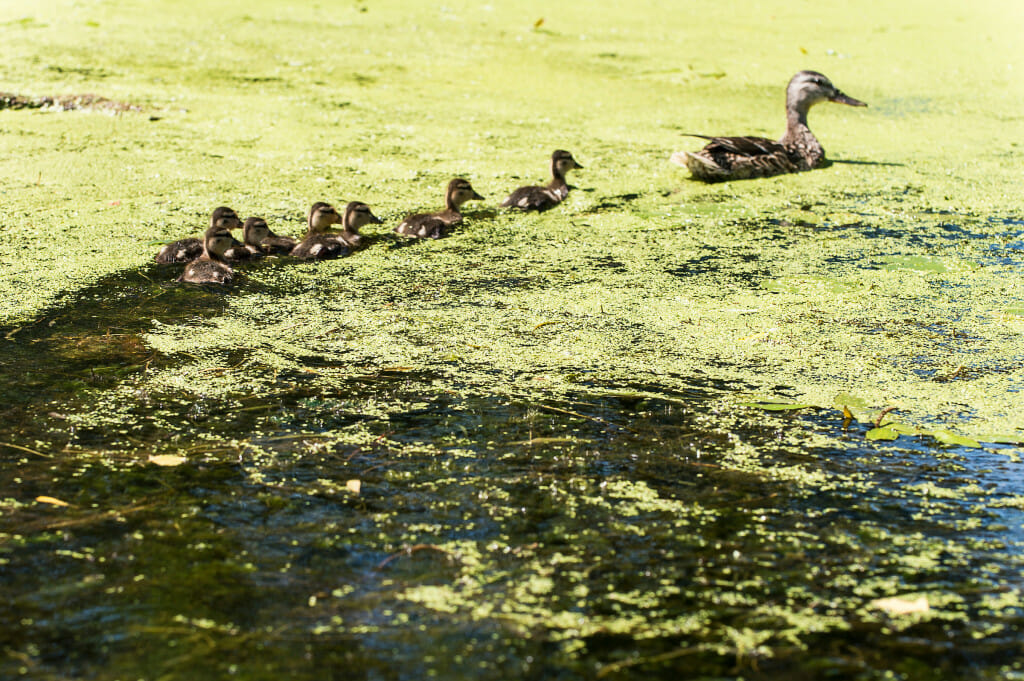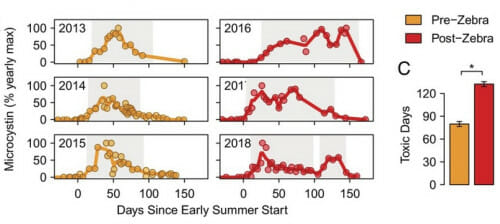Earlier algae blooms, lingering toxins: Invasive species cause big changes to a lake’s microbial community

A family of ducks swims through duckweed and algae in Dorn Creek Marsh on the northern edge of Lake Mendota. New research from UW–Madison limnologists shows extended algae bloom seasons following the invasion of the lake by spiny water fleas and zebra mussels. Photo: Jeff Miller
New research from University of Wisconsin–Madison scientists traces two tiny invasive species through their outsized effects on the water quality, algae blooms and toxic conditions in a Wisconsin lake.
Lake Mendota in Madison, Wisconsin, has seen two different invasions in the last 15 years. Researchers first documented large populations of an invasive zooplankton called the spiny water flea in 2009 and then spotted the early stages of a zebra mussel infestation in 2015.
Robin Rohwer, lead author of the study conducted when she was a UW–Madison graduate student and published recently in Proceedings of the National Academy of Sciences, wanted to know what these invasions meant for the microscopic organisms she studied. Luckily, Lake Mendota is home to a long-term research program collecting data on the lake since the early 1980s, allowing Rohwer and her colleagues to get a clearer picture of the substantial changes that followed the zebra mussel and spiny water flea invasions.
“We looked at the microbial community on three levels and saw major changes in all three,” says Rohwer, who is now a postdoctoral researcher at the University of Texas at Austin.
First, Rohwer and her colleagues found that following both the spiny water flea and the zebra mussel invasions, cyanobacteria, also called blue-green algae, were beginning to appear in the lake earlier each year, interrupting Lake Mendota’s usual spring clear-water phase and kicking off harmful algae blooms, which effectively extended the lake’s algae season.
What’s more, the diversity of cyanobacteria found in the lake substantially increased during the summer seasons. And it wasn’t just a few new species showing up, Rohwer says, but changes in the fates of entire genera, families and even orders of these microbes.
In addition to increased diversity and longer cyanobacteria seasons, Rohwer, with help from colleagues at the Zilber School of Public Health at the University of Wisconsin–Milwaukee, detected a second shift: a dramatic increase in toxic water conditions after the zebra mussel invasion. They examined water samples for microcystin, one of the more common toxic compounds produced by some cyanobacteria.
“We saw an increase in early summer toxicity and a lengthening of the toxin-production season,” Rohwer says.

Days in which toxins produced by cyanobacteria persisted in Lake Mendota stretched deeper into the summer following the arrival of a pair of invasive species. Robin Rohwer
In all, the amount of time Lake Mendota spent with detectable levels of microcystin each year increased, on average, by more than 50 days. Surprisingly, the increase in these toxins wasn’t due to an increase in the cyanobacteria. Somehow, toxic conditions in the lake lingered.
“We think it might be due to a more complex ecological reason, like microbial community interactions or nutrients shifting with the zebra mussel invasion,” Rohwer says. “It’s not just a simple change, like more Cyanobacteria making more toxins.”
Finally, the impacts of spiny water flea and zebra mussels rippled far beyond cyanobacteria. Rohwer observed huge shifts in abundance for many other kinds of bacteria in the lake. There were winners and losers among microbes after the arrival of these two invasive species, she says. Bacteria shifted abundance, in particular, in seasons in which they were already dominant, becoming even more abundant while less-profligate populations dwindled.
For microbiologists, this last finding may be the most profound. Unlike cyanobacteria, it is thought that what are called the heterotrophic bacteria living in a lake aren’t very sensitive to what’s going on in the overall ecosystem.
Since they should be relatively unaffected by disruptions to the food web, “microbes are often overlooked by ecosystem scientists,” says Trina McMahon, a professor in the Department of Bacteriology at the University of Wisconsin–Madison and contributing author to the report. “This study shows that their biodiversity can be altered by invasive species that are known to impact higher levels in lake food webs, with consequences for water quality.”
The widespread impacts throughout Lake Mendota’s microbial community demonstrate the interconnectedness of microbes with the broader food web and their susceptibility to long-term environmental change, according to the researchers.
“The big question that inspired the work was, can I link disruptions from invasive species to the microbial communities and really show those connections between microbes and the broader food web?” Rohwer says. “And I was obviously very excited to see that I could.”
A question like that is easier to ask on one of the best-studied lakes in the world. Not only has Lake Mendota been the site of freshwater research since the end of the 1880s, the lake is also part of the North Temperate Lakes Long-term Ecological Research program, an endeavor funded by the National Science Foundation, which has allowed scientists to monitor conditions in the lake for more than forty years.
“Our study would’ve been impossible without long-term data,” Rohwer says, adding that datasets like these will allow future studies to ask big questions about big environmental changes and, quite possibly, find some unexpected answers of their own.




